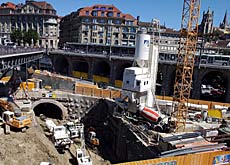The hills are alive with the rumble of trains

Listen closely and you might catch the faint squeal of brakes of the ghost-like trains shuttling beneath Lausanne.
With just over a year to go before the grand opening of the new Lausanne underground railway, trains have started testing part of the six-kilometre north-south line. swissinfo checks out preparations on the fledgling network.
London, New York, Paris… Lausanne. Underground systems are generally designed for cities of at least one million inhabitants, but Lausanne – the Olympic Capital – is a small city with big ambitions.
Switzerland’s San Francisco, built on a series of steep hills above Lake Geneva and with a growing population of 250,000, is giving itself a makeover.
Part of this involves the construction of a new metro, the world’s first automated driverless system able to handle its steep slopes and Switzerland’s first underground.
“The major challenge of the M2 metro is the hills that have to be mastered,” echoes our guide, Michel Baud. “The metro will climb slopes with an average six per cent gradient, with the steepest parts at 12 per cent – a world first.”
From October 2008 some 25 million people a year are expected to use the M2 which will climb from the crystal-blue lake waters at Ouchy to the woody hills above the city near Epalinges in just 20 minutes, slashing the normal journey time by half.
The M2 is set to become the “spinal column” of Lausanne’s transport network, but it is hoped it will also have a strong environmental impact.
Much of the city centre suffers from vehicle pollution, particularly in summer – high concentrations of nitrogen dioxide have been recorded, above levels fixed by federal authorities.
Digging deep
For the past three years, Lausanne’s inhabitants have had to grow used to the dust, noise and cranes dotting the skyline as workers beaver away to finish the M2, which is based on similar metro lines in Paris and Singapore.
“We haven’t invented anything new; we’ve simply adapted existing technologies for Lausanne’s particularity – its hills,” said Baud.
Grooved tracks will help improve adhesion. The trains themselves will be fitted with the same tyres as those on the Paris metro, but are expected to wear out much quicker. And the sophisticated braking systems have to be carefully adjusted, as going downhill “the trains actually brake too well”.
A great deal of technical know-how and equipment has been imported, mainly from the French firm Alstom. Otherwise the Swiss have been managing the overall project and were responsible for the tunnelling, which was completed in July 2006.
As Lausanne is built on compact sandy soil, the actual digging was not too problematic.
“But at times it felt like we excavating the 350,000 cubic metres of earth with a spoon,” said Baud, adding that urban building sites “can also sometimes come up with geological surprises”.
On February 22, 2005 McDonalds customers at Place Saint-Laurent got a big shock when a 10-metre hole suddenly appeared directly outside the restaurant front door. The tunnelling team had pierced an underground lake which had caused the ground to subside.
“We were very lucky that no one was killed or hurt,” said Baud.
Light at end of tunnel
With the construction work and track laying now over, the teams are now starting to see light at the end of the tunnel. The next stage is the completion of the 14 stations, alongside an intensive yearlong testing phase to ensure the driverless system meets strict safety standards.
An automatic system is probably safer than a manual one, Baud claims. “It’s never tired, there’s no stress and you can stop at stations with a precision of ten centimetres.”
By the time it opens next autumn, the whole project is expected to have cost SFr706 million ($580 million) – far too expensive for a city the size of Lausanne, say critics.
But despite the noise, disturbance and cost, the M2 seems to have captured local people’s imagination. The project was accepted by 62 per cent of voters in a cantonal referendum in 2002, and since 2004, some 150,000 curious locals have visited the new tunnels and stations.
“People are impatient to start using the metro,” said Baud.
swissinfo, Simon Bradley in Lausanne
Length: 6km between Ouchy (373m) and Epalinges (711m).
Journey time from Ouchy to Epalinges: 18 minutes (train every 3 minutes during peak times).
Average gradient: 5.7%; steepest section: 12%.
Maximum speed: 60 km/h.
Capacity: 25 million passengers per year or 6,600 passengers per hour in each direction.
Number of stations: 14.
Number of trains: 15 (each train comprises two compartments).
Train capacity: 220 passengers.
Construction work started: June 17, 2004.
Last tunnel bored: July 28, 2006.
Lausanne’s M1 metro line, which opened in 1991, links the centre of town with Renens and stops at the Federal Institute of Technology in Lausanne.
130 years ago, Lausanne opened “La Ficelle”, Europe’s first cable funicular railway linking the city centre and Ouchy.
The M2 metro project and budget was officially accepted by the Vaud people in a referendum on November 24, 2002 (62%).
Budget: SFr706 million, jointly financed by the Swiss government (12%), canton Vaud (71%) and City of Lausanne (17%).
Planned official opening: September-October 2008.
There are around 20 automatic metros in the world, including those in Paris, Lyon, Rennes, Lille, Toulouse, London (Docklands Light Railway), New York, Singapore and Nuremberg.

In compliance with the JTI standards
More: SWI swissinfo.ch certified by the Journalism Trust Initiative












You can find an overview of ongoing debates with our journalists here . Please join us!
If you want to start a conversation about a topic raised in this article or want to report factual errors, email us at english@swissinfo.ch.